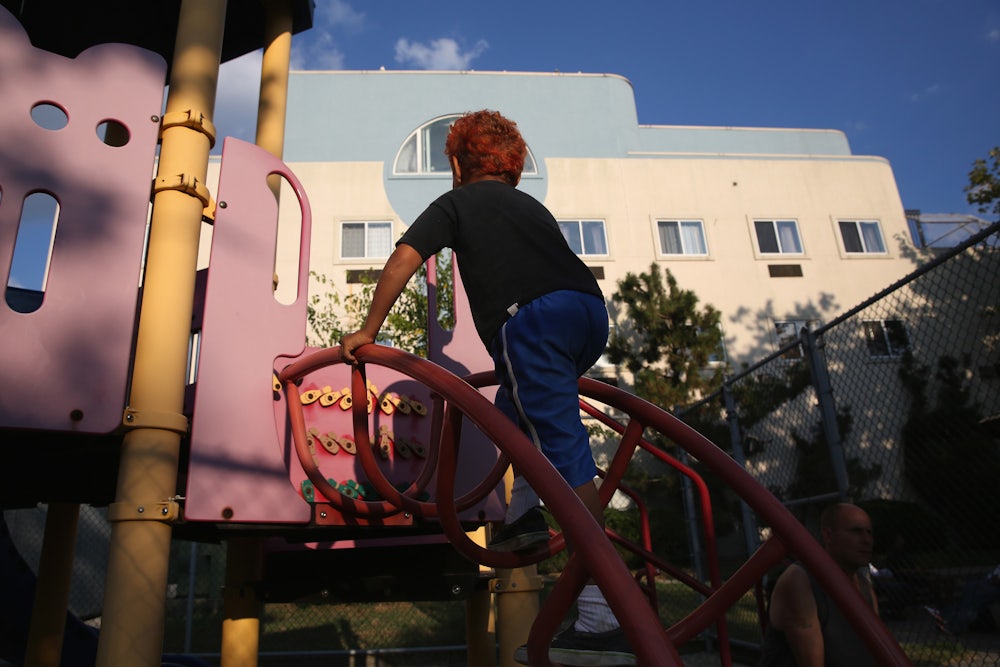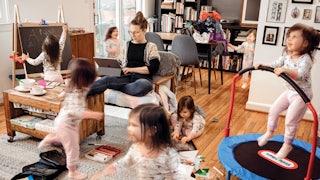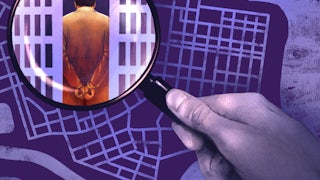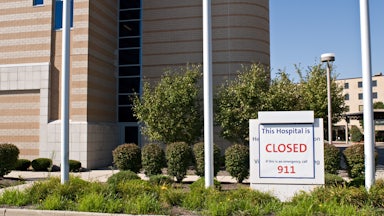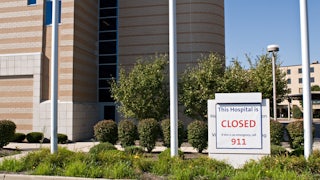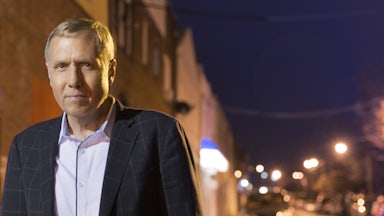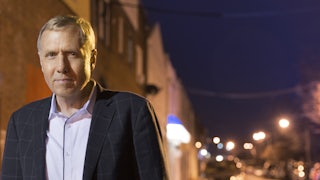It began as a natural, unplanned experiment. In March 2020, when schools shut down to curb the spread of Covid-19, the system charged with keeping kids safe also went on an unprecedented pause. As children sheltered out of sight from teachers, doctors, and other mandated reporters who are legally obligated to report suspicions of child abuse or neglect, the number of reports plummeted. Poor urban neighborhoods that previously had thousands of investigations for child maltreatment each year experienced a sudden drop in protective workers at doors. Of the investigations that marched onward, some moved out of families’ homes and onto computer screens. And when child protective workers did come knocking? Many phoned ahead to ensure no one was sick, giving parents a chance to prepare.
Some experts feared the worst: that removed from the watchful eyes of the child welfare system, kids were suffering. Pediatricians, government officials, and researchers warned that the economic and emotional toll of the pandemic was fueling a parallel, hidden epidemic of child abuse. “There are kids behind closed doors that may be trapped with their abusers and there’s no way for them to get help,” Bronx District Attorney Darcel Clark told NBC New York.
But a group of mothers, attorneys, and other advocates who know the foster care system from the inside saw things differently. They had long considered the system overzealous in its investigations of poor Black and brown families. So when child protective services began operating at a whisper of its former self, where others saw danger, these women saw opportunity. “I think this could be a test where the numbers end up showing that we don’t need the mandated reporter system at all,” says Chris Gottlieb, co-director of the New York University School of Law’s Family Defense Clinic. She was speaking to me for a CityLab article in June 2020, when New York City’s child welfare agency reported a 51 percent decline in child abuse cases.
More than a year later, indicators suggest that in New York City, at least, the advocates were right: There was no spate of undetected child abuse throughout the five boroughs. That’s according both to a forthcoming paper in the Columbia Journal of Race and Law by Anna Arons, an acting assistant professor of lawyering at New York University, and to the New York City Administration for Children’s Services itself. In June, ACS Commissioner David Hansell acknowledged the lack of evidence for undetected abuse, saying it was just as likely the pandemic was “a very positive thing” for children who spent more time with their parents, reported The Imprint.
Now mothers with firsthand experience of child welfare plan to use this finding to advance an ambitious agenda to transform the system’s approach to family safety, which they say is rooted in racist notions of nonwhite motherhood. They argue the pandemic demonstrated that the level of child welfare surveillance that low-income moms of color routinely experience is excessive, ultimately doing more harm to kids than good. Among their requests to lawmakers: that mandated reporting be revamped, that parents under investigation be presented with a kind of “Miranda rights,” and that family and community supports be detached from traumatic surveillance. Advocates say the asks are the first steps toward realizing a parent-informed blueprint to overhauling child welfare and replacing it with a new vision of child safety that grants poor Black and brown parents the same dignities routinely allotted other parents. These include that they are not guilty before a finding; that a call for help is met with support rather than suspicion; and that there is an assumption that parents know what their families need.
“Instead of thinking that ACS is going to solve anything, the funding needs to go back to the community, because the community knows what the community needs,” explains Nancy Fortunato, who is a member of the advocacy groups the Parent Legislative Action Network and Voices of Women Organizing Project and who spent, as a young mother, over a year under the watch of children’s services while living in a domestic violence shelter with her kids. Ultimately, it’s a vision of child and community safety built around support instead of surveillance.
Parent activists who have experienced child welfare, like Fortunato, call it the “family regulation” or “family policing” system—that vast network of child protective, foster care, and family support services whose investigations involved roughly 3.5 million children in 2019 and removed nearly 246,000 of those kids from their homes. For years, these mothers have talked about two types of parents: those who view childcare workers, teachers, and pediatricians as a benign, helpful presence, and those parents who remain hyperaware that these professionals are, legally, the eyes and ears of the system and have the authority to take their children away.
If you’re white and affluent, you likely fall into the blissfully unaware camp, says Joyce McMillan, a Black mother who has made it her life’s work to defund the system that ripped apart her family and to push for holistic family and community supports. If you’re poor and a person of color, says McMillan, you know that even the most routine trip to the doctor can trigger a child welfare investigation.
If that sounds extreme, consider this: Over half of all Black kids in the U.S. will be part of a child welfare investigation—that’s compared with about 28 percent of white kids. Black and brown children continue to be disproportionately represented in every stage of the child welfare process, from who gets taken from their home, to who languishes in foster care the longest, to who ages out of the system without legal ties to a parent.
Economic hardship, which research links to child maltreatment, is part of this picture. Most children in foster care are there not because they’ve been abused, but because of findings of neglect, a classification almost always fueled by poverty. Not having the means to stock the refrigerator, pay the electric bill, or secure safe childcare can add up to a neglect case in family court, and turning to government services for assistance with, say, counseling or drug treatment makes a family’s difficulties more visible. It doesn’t help that while over $5 billion in federal funds are spent annually on foster care services, many of the concrete resources demonstrated to keep kids out of care—like affordable housing, economic supports, and Head Start—remain in short supply.
Plenty of research also points to racial bias being at play in the overrepresentation of Black and brown children in child welfare. One study from the Children’s Hospital of Philadelphia found doctors were more likely to evaluate Black children for abuse than white children, and more likely to report injuries when they appeared on Black and brown children.
Another study, published in The New England Journal of Medicine, found Black women were more likely than white women to be reported for substance use while pregnant, despite similar levels of use. And a study in Texas demonstrated that, even controlling for assessed maltreatment risk and family income, caseworkers were more likely to remove Black children from their parents than white kids. The “effect of racial bias on decision-making remains an important consideration in understanding the overrepresentation of African American children,” those authors concluded.
Jessica Marcus, a senior supervising attorney for law and appeals at Brooklyn Defender Services, agrees. “There’s implicit bias at every level of the child welfare system, starting with who decides to call in the cases,” she says. “The level of reporting reflects more bias than actual risk.”
When child protective workers investigate phoned-in suspicions, the goal is to determine whether kids are in danger and to connect struggling families with support. But parents say the investigations themselves inflict harm: Children’s bodies are searched for signs of abuse; neighbors, teachers, and babysitters may be interrogated about a mother’s parenting; and parents—overwhelmingly low-income moms of color—must prove to a government authority their fitness to parent, often as their children look on.
“The minute you know that children’s services is going to come in your home, you get that fight-or-flight feeling. Your mind is wondering, ‘Are they going to take my children away? What are my rights? What should I say or not say?’” Fortunato says. “They aren’t coming in as a resource of support. They are coming in judgment.”
Fortunato adds that while parents may need and want the services offered by child welfare services—like childcare or therapy—the surveillance and threat of removal that comes with them keeps many families far away.
Angeline Montauban, whose son spent five years in foster care, knows mothers who have lost jobs trying to comply with child welfare services and appointments. She likens the scrutiny to being on parole without being found guilty. “They can pop in at any hour. They’re asking about your personal life, they’re looking in your refrigerator. A lot of these mothers, they’re single mothers, and their children is everything they have,” she says.
Investigations are startlingly inefficient at identifying child maltreatment. More than 80 percent of the millions of investigations in 2019 resulted in no finding of abuse or neglect. Advocates say that shows child welfare systems cast too wide and harmful of a net, siphoning resources from true cases of child abuse and concrete services, like housing, while adding strain to millions of struggling families each year. “It’s the stop and frisk of child welfare,” says McMillan.
But before the number of reports plummeted in 2020, no one knew what might happen in the absence of mandated reporting: With a pared-down system, would more children be harmed? Now the data is coming in, and it shows “what we always knew” about mandated reporting, says Erin Miles Cloud, co-director and co-founder of the nonprofit Movement for Family Power: “Our kids are safe without it.”
At a New York City Council hearing in June, ACS Commissioner Hansell said there were no significant changes in emergency room usage citywide during the pandemic, which he said one might expect “if there were more children suffering any kind of serious physical abuse,” reported The Imprint. Meanwhile, the rate of investigations leading to a maltreatment finding has also remained largely steady throughout the pandemic, said Hansell. One indicator in the analysis by NYU’s Anna Arons suggests that child abuse may have slightly decreased after schools closed: During several months of 2020 that included lockdowns, New York City experienced 25 percent fewer child fatalities than during the same period in 2019.
Miles Cloud, whose organization receives funding for child welfare abolition, says she is strategizing with parents, doctors, and other advocates about how this information can push change, and is part of a parent-led collective urging New York State’s Legislature to pass three bills that would narrow the “front door” to the country’s largest child welfare system. Advocates say that together these bills would reduce the number of families investigated, while giving power and dignity back to parents under the system’s scrutiny.
One proposed law bans anonymous calls to the state child maltreatment hotline in lieu of confidential calls, something advocates say discourages fabricated or malicious reports. A second bill bars medical providers from testing pregnant mothers and newborns for drugs or alcohol without a mother’s consent—a practice activists say is common in hospitals serving low-income women of color and fuels a mistrust of health providers while sometimes leading to damaging interventions and practices. Such tests “are not the proper assessment of addiction, not an evaluation of harm to the newborn, and not a parenting test,” Mishka Terplan, a physician boarded in both OBGYN and addiction medicine, explained in a release about the proposed legislation.
The bill considered the most controversial requires child protection workers to notify parents of their rights at the onset of an investigation, including that they do not need to let investigators into their home without a court order. Some fear this would thwart child protective workers from quickly reaching children who are in danger, but parent advocates say it’s a civil rights issue. “People who have been arrested know what their rights are on the criminal side, but no one knows what their rights are when dealing with” child protection, says McMillan.
Progressive child welfare reform has long been a tough legislative sell. No one wants children harmed, and child welfare systems are, after all, the organizations tasked with keeping kids safe. People regard them as the government body “that helps people, that helps families,” says Imani Worthy, a mother who is part of the movement for change and a co-director at Rise, a New York nonprofit that advocates for child welfare–impacted parents.
But activists say the resistance to thinking critically about child welfare is also fueled by a mistrust of nonwhite motherhood. “Most of us Black women and Black children come in contact with the child welfare system, and we are fighting this public image of who we are. The system gives the air that these are people who need to be reformed, they need to be corrected, and there’s something wrong with us,” says Montauban.
When Montauban’s toddler son was taken by child protective workers several years ago, she struggled to find allies who grasped the big picture of her experience. Even advocates fighting to reform criminal justice or to eradicate poverty “didn’t see child welfare as part of the struggle of Black people in America. They didn’t make that connection.”
But Montauban is among the Black and Latinx moms I spoke with who say that in recent months they have experienced increased support for the once-fringe notion that the system charged with protecting children is, in fact, causing its own brand of damage. It’s a cognitive shift they attribute to the national reckoning with systemic racism sparked by George Floyd’s murder, as well as by a newfound willingness of mothers to speak openly about an experience that had felt, to many, too private and shameful to share: the experience of being labeled a bad mom.
“We are at a critical milestone,” says Miles Cloud. “We are in the midst of visionaries who are leading us to a huge shift in how we think of family safety.”
Over the past year, impacted parents have been sharing their experiences with reporters, at conferences, and on megaphones. They’ve peppered New York City neighborhoods with posters bearing slogans including “From the plantation to the present, breaking up Black families has always meant profit.” On Martin Luther King Jr. Day, members of McMillan’s advocacy and empowerment organization JMacForFamilies and other activists celebrated the installation of a giant billboard in East Harlem reading “Some cops are called caseworkers.” Another demonstration led a group of about 200 protesters to the Manhattan dormitory for children awaiting foster care placement. As parents chanted outside, teenagers emerged from the building to watch. Some stared, a few laughed, others joined in chanting. “I hope it showed them that parents are fighting for them, that they didn’t abandon them,” said McMillan.
Policymakers are listening, too. At the prodding of parent advocates, the New York City Commission on Human Rights launched an investigation last fall into whether hospital drug testing of newborns and parents discriminated against Black and Latinx families. Soon after, New York City’s public hospitals announced a new policy requiring written consent for drug testing.
This year, parent advocates in Washington state helped pass a law offering families supports detached from the child welfare system. Around the same time, the national child advocacy organization Children’s Rights released a report linking child welfare with government “oppression of Black children and families through traumatic surveillance, investigation, and family separation practices.”
New York City’s ACS Commissioner Hansell penned a New York Daily News op-ed acknowledging that systemic racism was at play in child welfare systems nationwide and vowed to do better. “To combat systemic racism in the child welfare system, we at ACS must look internally at our own structures, policies, practices and implicit biases—and we are,” he wrote.
In addition to requiring implicit bias training for staff, ACS wants to ensure mandated reporters also receive the training along with information on how to connect families to supports without calling the child maltreatment hotline. It is also expanding access to childcare, community hubs of support, and a program that lets some parents named in a maltreatment report avoid investigations by accepting services.
“The best way to keep children safe is to provide their families with the services and supports they need, in the least obtrusive way possible,” an Administration for Children’s Services spokesperson wrote in an email. “ACS is committed to continuing to expand services and supports to strengthen families, keep children safe, and take steps to reduce the disproportionality in the child welfare system.”
But several mothers countered that when help comes attached to the same system, it won’t be effective. Many activists say they are now aiming for the kind of sweeping revamping of child safety endorsed by Dorothy Roberts, a University of Pennsylvania professor. Twenty years ago, Roberts wrote a groundbreaking book critiquing child welfare policies and practices, which she links to slavery. In a June keynote speech at Columbia University, Roberts said she had since moved from hoping for child welfare reform to wanting abolition. “The family policing system can’t be fixed,” she said, urging the audience of parents, policymakers, academics, and advocates to work collectively to dismantle the system and replace it with “a radically reimagined way of caring for children and their families.”
During the early months of the pandemic, Jeanette Vega, co-executive director of Rise, caught glimpses of a radically compassionate agenda for child safety. She saw it in the mutual aid networks sprouting across the city, as well as in her own Bronx neighborhood, where, pre-pandemic, people generally kept to themselves, but during lockdowns neighbors came together—taking turns with homeschooling, sharing washing machines, and, for material needs, turning to the local grassroots groups manned not by a government agency but by each other. “In New York City, we were there for each other. We connected with our friends and our neighbors, and from that our families have been safe, and our children have been safe,” says Vega. “We don’t need system involvement.”
